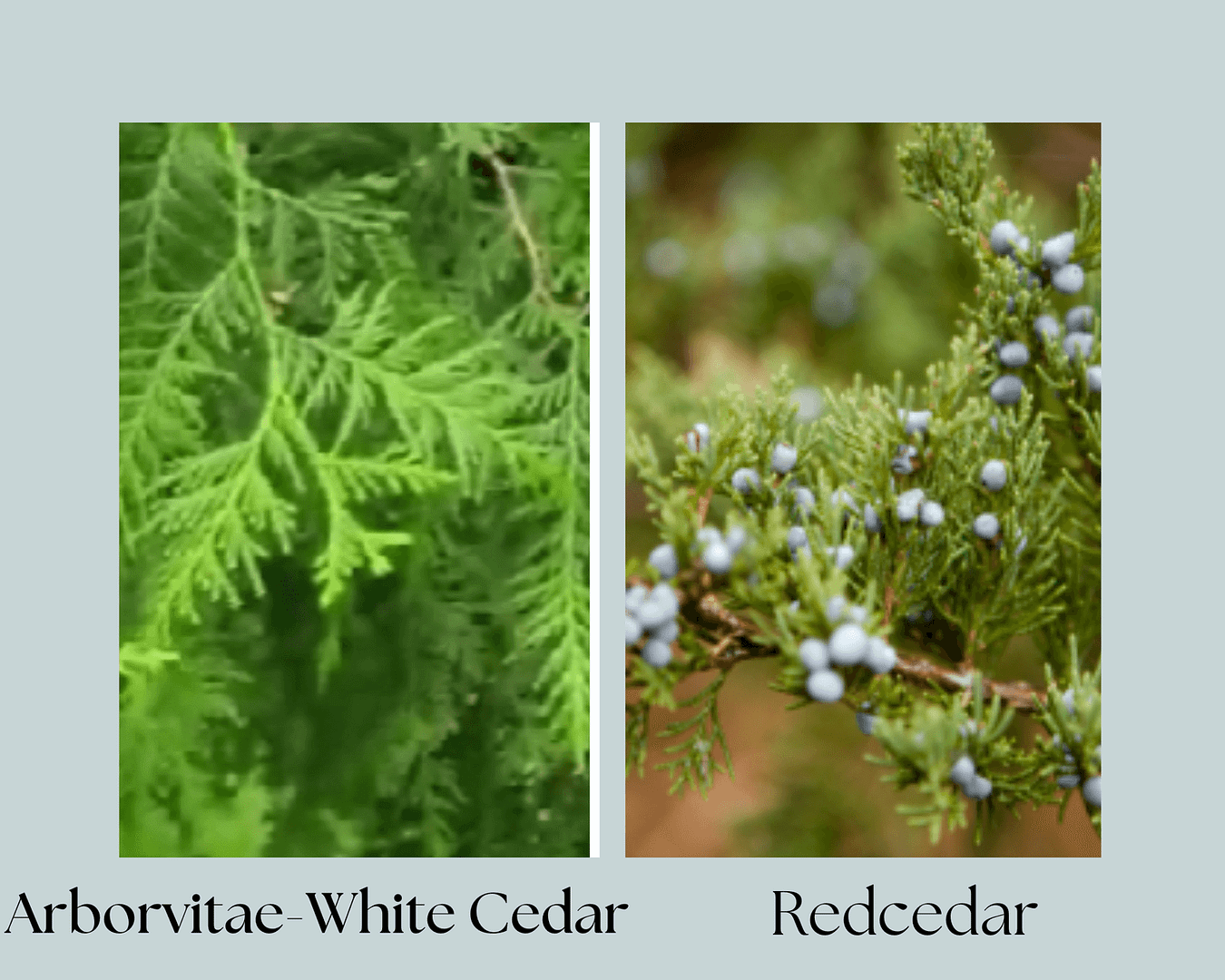REDCEDAR AND ARBORVITAE
How to tell them from other trees: The red cedar (juniper) and arborvitae may be told from other trees by their leaves, which remain on the tree and keep green throughout the entire year. These leaves differ from those of the other evergreens in being much shorter and of a distinctive shape.
The trees themselves are much smaller than the other evergreens enumerated in this book. Altogether, there are thirty-five species of juniper recognized and four of arborvitae. The junipers are widely distributed over the northern hemisphere, from the Arctic region down to Mexico in the New World, and in northern Africa, China, and Japan in the Old World. The arbor-vitae is found in northeastern and northwestern America, China, and Japan. The species mentioned here are those commonly found in America.
How to tell them from each other: The twigs of the arbor-vitae are flat and fan-like as in the twigs of the red cedar are needle-shaped or scale-like. The foliage of the arborvitae is of a lighter color than that of the red cedar, which is sombre green. The arborvitae will generally be found growing in moist locations, while the red cedar will grow in dry places as well.
The arborvitae generally retains its lower branches in open places, while the branches of the red cedar start at some distance from the ground.
RED CEDAR ( Juniperus virginiana)
Distinguishing characters: The tree can best be told at a glance by its general form, size and leaves. It is a medium-sized tree with a symmetrical, cone-like form, which, however, broadens out somewhat when the tree grows old. Its color throughout the year is dull green with a tinge of brownish red, and its bark peels in thin strips.
Leaf: In young trees the leaf is needle-shaped, pointed, and marked by a white line on its under side. In older trees it is scale-like, and the white line on its under side is indistinct.
Range: Widely distributed over nearly all of eastern and central North America.
Soil and location: Grows on poor, gravelly soils as well as in rich bottom lands.
Enemies: The “cedar apple,” commonly found on this tree, represents a stage of the apple rust, and for that reason it is not desirable to plant such trees near orchards. Its wood is also sometimes attacked by small boring insects.
Value for planting: Its characteristic slender form gives the red cedar an important place as an ornamental tree, but its chief value lies in its commercial use.
Commercial value: The wood is durable, light, smooth and fragrant, and is therefore used for making lead-pencils, cabinets, boxes, moth-proof chests, shingles, posts, and telegraph poles.
Other characters: The fruit is small, round and berry-like, about the size of a pea, of dark blue color, and carries from one to four bony seeds.
Other common names: The red cedar is also often called juniper and red juniper.
Comparisons: The red cedar is apt to be confused with the low juniper ( Juniperus communis) which grows in open fields all over the world. The latter, however, is generally of a low form with a flat top. Its leaves are pointed and prickly, never scale-like, and they are whitish above and green below. Its bark shreds and its fruit is a small round berry of agreeable aromatic odor.
Ornamental: Seedlings of red cedar are ordinarily used as stock for grafting ornamental juniper clones. Red cedars are often used as ornamentals for their
evergreen foliage. Most cemetery plantings include old red cedar trees and many younger dwarf junipers. All of the native junipers are valuable ornamental
species, and many horticultural varieties have been developed. Red cedar is widely used in shelterbelts and wildlife plantings. The close-grained, aromatic,
and durable wood of junipers is used for furniture, interior paneling, novelties, and fence posts. The fruits and young branches contain aromatic oil that is used in medicines.
Wildlife: Red cedar and other junipers are important to wildlife throughout the country. Their twigs and foliage are eaten extensively by hoofed browsers, but
the chief attraction to wildlife is the bluish-black berry-like fruit. The cedar waxwing is one of the principal users of red cedar berries, but numerous other birds and mammals, both large and small, make these fruits an important part of their diet. In addition to their wildlife food value, cedars provide important protective and nesting cover. Chipping sparrows, robins, song sparrows, and mockingbirds use these trees as one of their favorite nesting sites. Juncos, myrtle warblers, sparrows of various kinds, and other birds use the dense foliage as roosting cover. In winter, their dense protective shelter is especially
ARBORVITAE; NORTHERN WHITE CEDAR ( Thuja occidentalis)
Distinguishing characters: The branchlets are extremely flat and fan-like, and have an agreeable aromatic odor when bruised. The tree is an evergreen with a narrow conical form.
Leaf: Leaves of two kinds, one scale-like and flat, the other keeled, all tightly pressed to the twig.
Form and size: A close, conical head with dense foliage near the base.
Usually a small tree, but in some parts of the northeastern States it grows to medium size with a diameter of two feet.
Range: Northern part of North America.
Soil and location: Inhabits low, swampy lands; in the State of Maine often forming thick forests.
Enemies: Very seldom affected by insects.
Value for planting: Is hardy in New England, where it is especially used for hedges. It is also frequently used as a specimen tree on the lawn.
Commercial value: The wood is durable for posts, ties, and shingles. The bark contains considerable tannin and the juices from the tree have a medicinal value.
Other characters: The fruit is a cone about ½ inch long.
Other common names: Arborvitae is sometimes called white cedar and cedar.
Comparisons: The arborvitae is apt to be confused with the true white cedar ( Chamæcyparis thyoides) but the leaves of the latter are sharp-pointed and not flattened or fan-shaped.


